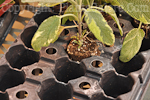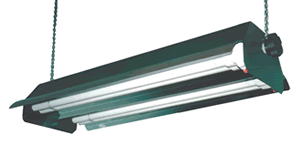 Starting
seeds indoors can be fun and quite rewarding. Planting seeds
and watching the seedlings grow seems to help move us toward
the warmth of spring.
Starting
seeds indoors can be fun and quite rewarding. Planting seeds
and watching the seedlings grow seems to help move us toward
the warmth of spring.
Before taking the plunge and lining every
window with seed trays, give some thought to the pros and cons
of growing seedling plants.
Starting your own seeds has a number of
advantages. It can be an enjoyable activity for those long
winter nights. Creating a "mini" garden under lights in the
basement can help combat couch potato tendencies at this time
of year.
 It
opens a whole array of new and unusual plant varieties not
commonly offered by local sources.
Catalogs are filled with
recent introductions and improved varieties of flowers and
vegetables.
It
opens a whole array of new and unusual plant varieties not
commonly offered by local sources.
Catalogs are filled with
recent introductions and improved varieties of flowers and
vegetables.
Grown properly, your own seedlings may be
ready to flower or produce a crop earlier than those planted
directly in the garden. The key is to prevent them from
becoming overgrown while waiting to be transplanted outdoors.
Some plants will never recover from poor treatment during the
seedling stage.
Unfortunately, there are also some major
negatives.
To avoid producing tall, spindly, weak
plants, supplemental light is a must. Usually, 14 to 16 hours
of fluorescent lighting placed near (3-5 inches) the plants is
required. The light stand must allow the lamp fixture to be
raised and lowered easily. This can be tricky.
 Sterile
media must be used to prevent the fungal disease called
"damping off" which kills seedlings a few days after
emergence.
Perlite or
vermiculite work well for germinating
the seeds. Seedlings should also be transplanted into sterile
potting soil for best results.
Sterile
media must be used to prevent the fungal disease called
"damping off" which kills seedlings a few days after
emergence.
Perlite or
vermiculite work well for germinating
the seeds. Seedlings should also be transplanted into sterile
potting soil for best results.
Certain seeds require bottom heating for
proper germination. Special cables and mats are available but
may be costly. Relying on general room heating may result in
slower germination or lower percentage of germination.
 When gardeners get itchy and start seeds too
early, they may run out of space for holding the seedlings
indoors. Vegetable seedlings held too long may not produce
well.
When gardeners get itchy and start seeds too
early, they may run out of space for holding the seedlings
indoors. Vegetable seedlings held too long may not produce
well.
Keep these factors in mind before deciding
to start seeds at home. If you just want to grow a few
annuals
and tomato seedlings, it may be simpler (and cheaper) to buy
bedding plants at the store.



